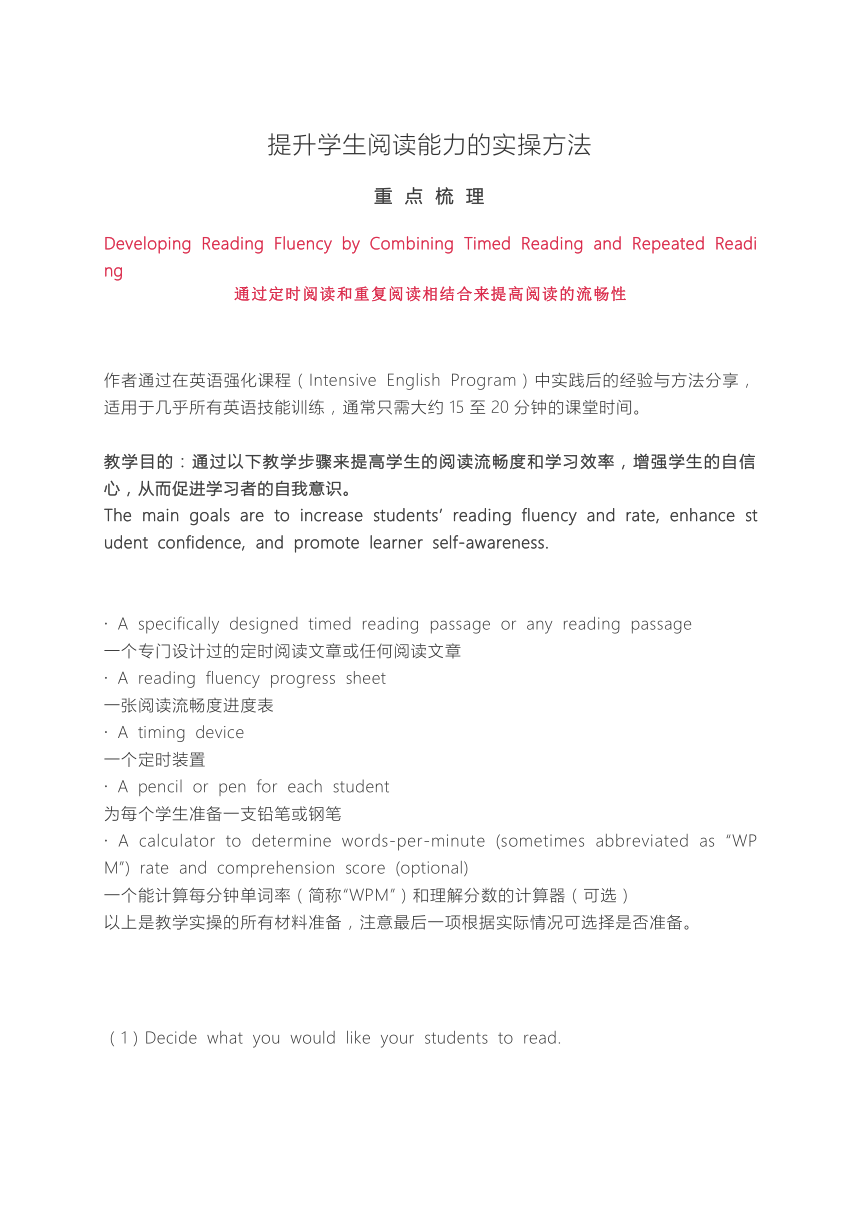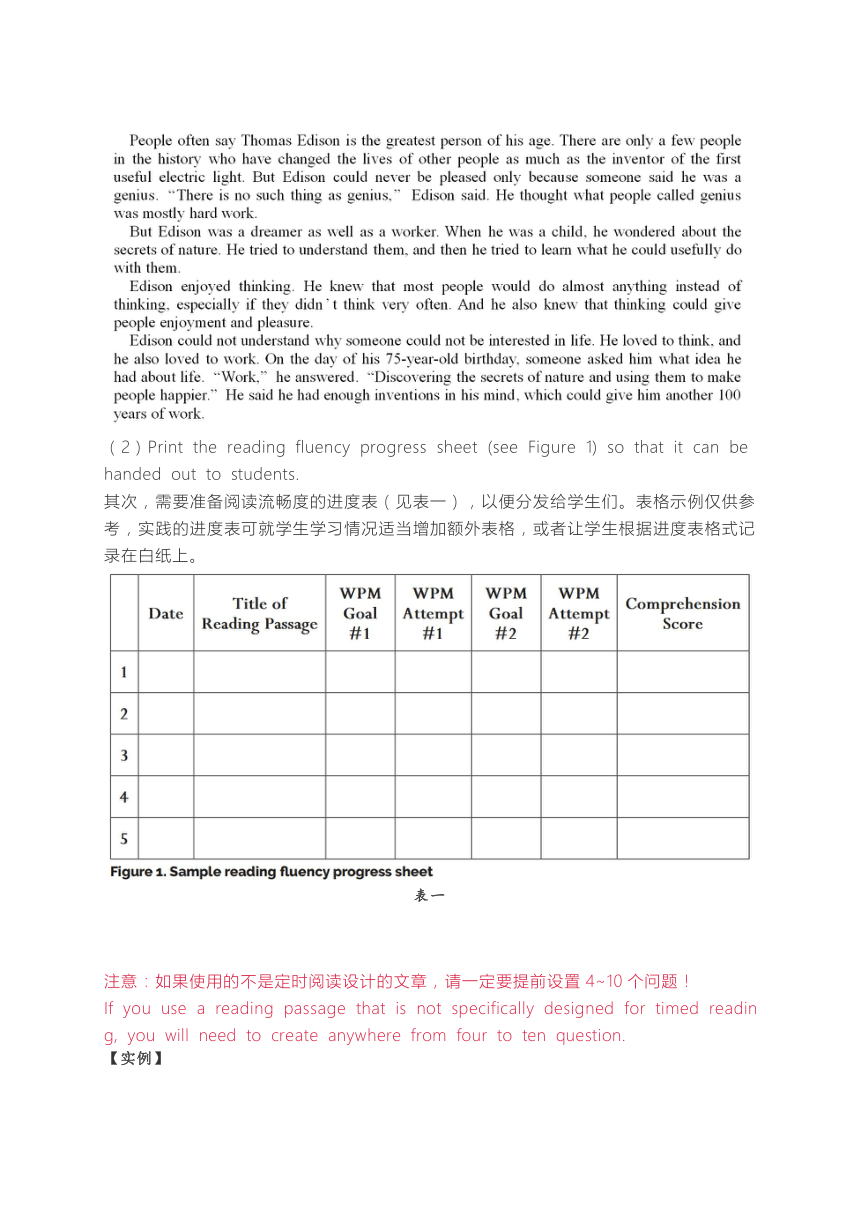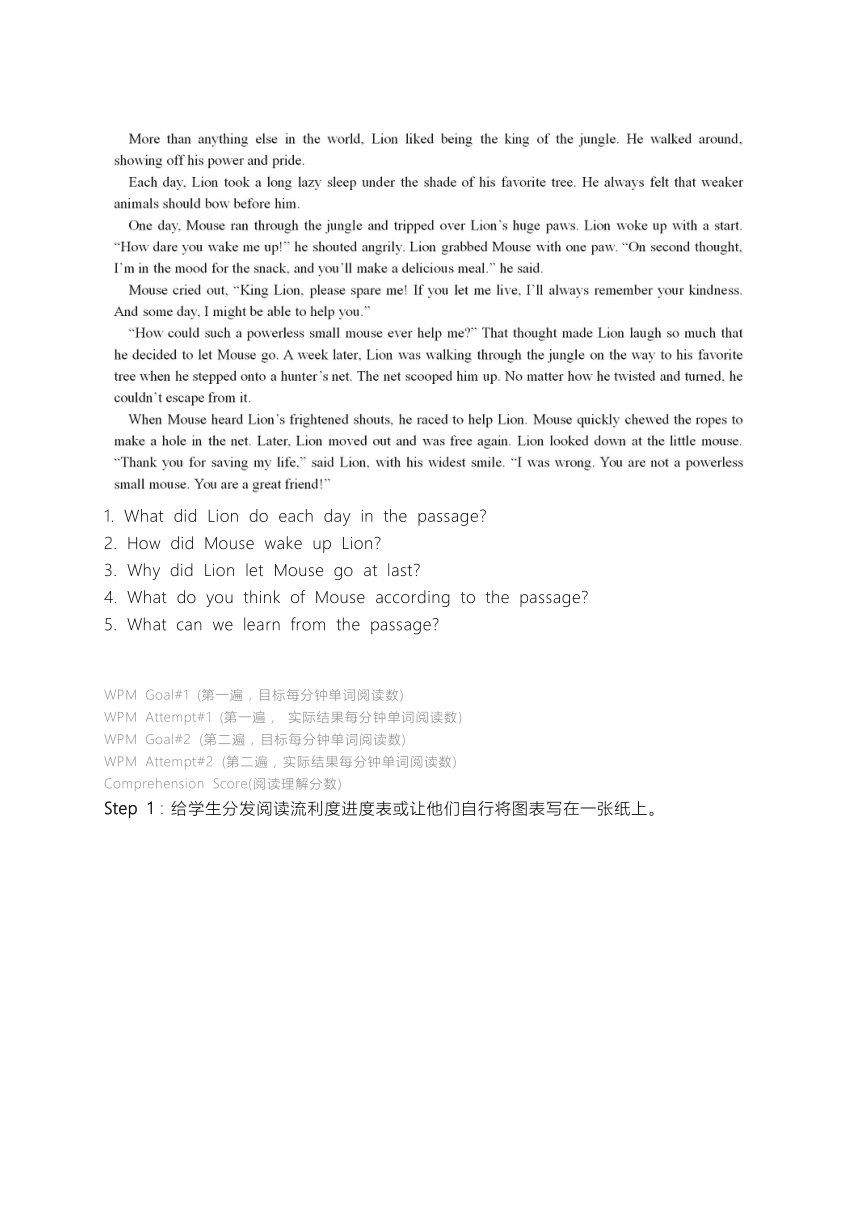提升学生阅读能力的实操方法教案
图片预览




文档简介
提升学生阅读能力的实操方法
重 点 梳 理
Developing Reading Fluency by Combining Timed Reading and Repeated Reading
通过定时阅读和重复阅读相结合来提高阅读的流畅性
作者通过在英语强化课程(Intensive English Program)中实践后的经验与方法分享,适用于几乎所有英语技能训练,通常只需大约15至20分钟的课堂时间。
教学目的:通过以下教学步骤来提高学生的阅读流畅度和学习效率,增强学生的自信心,从而促进学习者的自我意识。
The main goals are to increase students’ reading fluency and rate, enhance student confidence, and promote learner self-awareness.
1. 材料准备
· A specifically designed timed reading passage or any reading passage
一个专门设计过的定时阅读文章或任何阅读文章
· A reading fluency progress sheet
一张阅读流畅度进度表
· A timing device
一个定时装置
· A pencil or pen for each student
为每个学生准备一支铅笔或钢笔
· A calculator to determine words-per-minute (sometimes abbreviated as “WPM”) rate and comprehension score (optional)
一个能计算每分钟单词率(简称“WPM”)和理解分数的计算器(可选)
以上是教学实操的所有材料准备,注意最后一项根据实际情况可选择是否准备。
2. 课前准备
(1)Decide what you would like your students to read.
选择学生阅读什么内容是首要条件。无论是定时阅读文章的选择,亦或是任何阅读文章的选择,选择的基本原则是避免过于困难的文章,一定要符合学生英语水平。此外,建议选择相对较短的文章。
【实例】-针对不同学段
初一学生适合的文章(词数:130~200词)
初二学生适合的文章(词数:180~300词)
初三学生适合的文章(词数:210~350词)
(2)Print the reading fluency progress sheet (see Figure 1) so that it can be handed out to students.
其次,需要准备阅读流畅度的进度表(见表一),以便分发给学生们。表格示例仅供参考,实践的进度表可就学生学习情况适当增加额外表格,或者让学生根据进度表格式记录在白纸上。
表一
注意:如果使用的不是定时阅读设计的文章,请一定要提前设置4~10个问题!
If you use a reading passage that is not specifically designed for timed reading, you will need to create anywhere from four to ten question.
【实例】
1. What did Lion do each day in the passage?
2. How did Mouse wake up Lion?
3. Why did Lion let Mouse go at last?
4. What do you think of Mouse according to the passage?
5. What can we learn from the passage?
3. 实施过程
WPM Goal#1 (第一遍,目标每分钟单词阅读数)
WPM Attempt#1 (第一遍, 实际结果每分钟单词阅读数)
WPM Goal#2 (第二遍,目标每分钟单词阅读数)
WPM Attempt#2 (第二遍,实际结果每分钟单词阅读数)
Comprehension Score(阅读理解分数)
Step 1:给学生分发阅读流利度进度表或让他们自行将图表写在一张纸上。
Step 2:分发阅读短文或告诉学生们阅读课本中的哪一段,并让他们在进度表上记录日期和标题。
Step 3:让学生初次阅读文章时设定并记录每分钟单词阅读数。
Step 4:告知学生默读文章,并记录自己的阅读时间,注意不要查生词。
Step 5:学生阅读时需安静且快速,老师可在屏幕上显示秒表或让学生自己准备秒表器。
Step 6:学生记录自己每分钟单词阅读数,计算公式:([全文词数] / [以秒为单位计算的时间]) x 60。
Step 7:学生查找未知单词词意并记录。
Step 8:学生设定第二次阅读时的每分钟单词阅读数。
Step 9:学生默读文章,并记录自己的阅读时间,注意不要查生词,接下步骤如Step 5。
Step 10:学生记录自己第二次阅读的每分钟单词阅读数。
Step 11:在不参考课文的情况下,学生们回答有关课文的理解问题。
Step 12:学生检查答案并记录其阅读理解分数。
总结:
这项课堂活动是阅读课程开展的一种有效方式。这项活动有助于学生成为更为流利的阅读者,并且有助于学生在阅读中更好的把握时间。除此之外,学生将获得定期阅读的机会。同时建议老师们先自己尝试这项活动,了解并体验,这样会更有信心与学生一起进行活动。
This activity can be an effective way to begin most reading classes. I use it to start two of my four weekly classes. After the activity, I like to review student progress and give praise to my students as they progress. Because students set goals and record their progress, they become self-aware of and motivated by their progress. From my teaching experience, I have noticed that this activity helps my students become more fluent readers, and I have noticed that my students feel that this activity is a good use of time. Another benefit of this activity is that students receive regular opportunities for reading practice. I recommend, though, that teachers first try this activity themselves, as readers, to understand what the experience is like and to become confident when they use this technique with their students.
重 点 梳 理
Developing Reading Fluency by Combining Timed Reading and Repeated Reading
通过定时阅读和重复阅读相结合来提高阅读的流畅性
作者通过在英语强化课程(Intensive English Program)中实践后的经验与方法分享,适用于几乎所有英语技能训练,通常只需大约15至20分钟的课堂时间。
教学目的:通过以下教学步骤来提高学生的阅读流畅度和学习效率,增强学生的自信心,从而促进学习者的自我意识。
The main goals are to increase students’ reading fluency and rate, enhance student confidence, and promote learner self-awareness.
1. 材料准备
· A specifically designed timed reading passage or any reading passage
一个专门设计过的定时阅读文章或任何阅读文章
· A reading fluency progress sheet
一张阅读流畅度进度表
· A timing device
一个定时装置
· A pencil or pen for each student
为每个学生准备一支铅笔或钢笔
· A calculator to determine words-per-minute (sometimes abbreviated as “WPM”) rate and comprehension score (optional)
一个能计算每分钟单词率(简称“WPM”)和理解分数的计算器(可选)
以上是教学实操的所有材料准备,注意最后一项根据实际情况可选择是否准备。
2. 课前准备
(1)Decide what you would like your students to read.
选择学生阅读什么内容是首要条件。无论是定时阅读文章的选择,亦或是任何阅读文章的选择,选择的基本原则是避免过于困难的文章,一定要符合学生英语水平。此外,建议选择相对较短的文章。
【实例】-针对不同学段
初一学生适合的文章(词数:130~200词)
初二学生适合的文章(词数:180~300词)
初三学生适合的文章(词数:210~350词)
(2)Print the reading fluency progress sheet (see Figure 1) so that it can be handed out to students.
其次,需要准备阅读流畅度的进度表(见表一),以便分发给学生们。表格示例仅供参考,实践的进度表可就学生学习情况适当增加额外表格,或者让学生根据进度表格式记录在白纸上。
表一
注意:如果使用的不是定时阅读设计的文章,请一定要提前设置4~10个问题!
If you use a reading passage that is not specifically designed for timed reading, you will need to create anywhere from four to ten question.
【实例】
1. What did Lion do each day in the passage?
2. How did Mouse wake up Lion?
3. Why did Lion let Mouse go at last?
4. What do you think of Mouse according to the passage?
5. What can we learn from the passage?
3. 实施过程
WPM Goal#1 (第一遍,目标每分钟单词阅读数)
WPM Attempt#1 (第一遍, 实际结果每分钟单词阅读数)
WPM Goal#2 (第二遍,目标每分钟单词阅读数)
WPM Attempt#2 (第二遍,实际结果每分钟单词阅读数)
Comprehension Score(阅读理解分数)
Step 1:给学生分发阅读流利度进度表或让他们自行将图表写在一张纸上。
Step 2:分发阅读短文或告诉学生们阅读课本中的哪一段,并让他们在进度表上记录日期和标题。
Step 3:让学生初次阅读文章时设定并记录每分钟单词阅读数。
Step 4:告知学生默读文章,并记录自己的阅读时间,注意不要查生词。
Step 5:学生阅读时需安静且快速,老师可在屏幕上显示秒表或让学生自己准备秒表器。
Step 6:学生记录自己每分钟单词阅读数,计算公式:([全文词数] / [以秒为单位计算的时间]) x 60。
Step 7:学生查找未知单词词意并记录。
Step 8:学生设定第二次阅读时的每分钟单词阅读数。
Step 9:学生默读文章,并记录自己的阅读时间,注意不要查生词,接下步骤如Step 5。
Step 10:学生记录自己第二次阅读的每分钟单词阅读数。
Step 11:在不参考课文的情况下,学生们回答有关课文的理解问题。
Step 12:学生检查答案并记录其阅读理解分数。
总结:
这项课堂活动是阅读课程开展的一种有效方式。这项活动有助于学生成为更为流利的阅读者,并且有助于学生在阅读中更好的把握时间。除此之外,学生将获得定期阅读的机会。同时建议老师们先自己尝试这项活动,了解并体验,这样会更有信心与学生一起进行活动。
This activity can be an effective way to begin most reading classes. I use it to start two of my four weekly classes. After the activity, I like to review student progress and give praise to my students as they progress. Because students set goals and record their progress, they become self-aware of and motivated by their progress. From my teaching experience, I have noticed that this activity helps my students become more fluent readers, and I have noticed that my students feel that this activity is a good use of time. Another benefit of this activity is that students receive regular opportunities for reading practice. I recommend, though, that teachers first try this activity themselves, as readers, to understand what the experience is like and to become confident when they use this technique with their students.
同课章节目录
- 词法
- 名词
- 动词和动词短语
- 动词语态
- 动词时态
- 助动词和情态动词
- 非谓语动词
- 冠词
- 代词
- 数词和量词
- 形容词副词及其比较等级
- 介词和介词短语
- 连词和感叹词
- 构词法
- 相似、相近词比较
- 句法
- 陈述句
- 一般疑问句和否定疑问句
- 特殊疑问句及选择疑问句
- 反意疑问句
- 存在句(There be句型)
- 宾语从句
- 定语从句
- 状语从句
- 主谓一致问题
- 简单句
- 并列句
- 复合句
- 主谓一致
- 主、表语从句
- 名词性从句
- 直接引语和间接引语
- 虚拟语气
- 感叹句
- 强调句
- 倒装句
- 祈使句
- 句子的成分
- 句子的分类
- 题型专区
- 单项选择部分
- 易错题
- 完形填空
- 阅读理解
- 词汇练习
- 听说训练
- 句型转换
- 补全对话
- 短文改错
- 翻译
- 书面表达
- 任务型阅读
- 语法填空
- 其他资料
